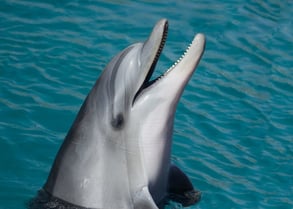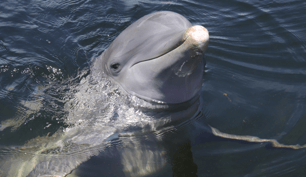Few marine animals are as adored as the Atlantic bottlenose dolphin. Humans love their playful spirit and friendly demeanor — but beyond this, most people know little about these remarkable dolphins.
To help you understand why Atlantic bottlenose dolphins are so special, we've highlighted a few of the most important (and intriguing) facts about these marine friends below:
Multiple Types of Bottlenose Dolphins
 For the purposes of this guide, we'll focus on the Atlantic bottlenose dolphin. A separate species (Tursiops aduncus) dominates the Indian ocean.
For the purposes of this guide, we'll focus on the Atlantic bottlenose dolphin. A separate species (Tursiops aduncus) dominates the Indian ocean.
Sometimes referred to as the common bottlenose dolphin, the Atlantic species is classified as Tursiops truncatus. Within this species, there are multiple subtypes that relate to habitat and behavior.
Recent research has revealed up to four main lineages of Tursiops truncatus. These include the coastal dolphins that have traditionally received the bulk of the attention, as well as open ocean dolphins and varieties native to the Black Sea and the Mediterranean.
The appearance and behaviors we'll discuss below will primarily relate to the coastal dolphins that continue to reside in the western areas of the Atlantic Ocean.
Gorgeous Coloration
When you picture a 'typical' bottlenose dolphin, which colors come to mind? In all likelihood, you imagine a light shade of gray. In reality, however, these stunning creatures are strategically colored to provide maximum protection from predators — so light gray alone won't cut it.
Atlantic bottlenose dolphins get much-needed camouflage from darker gray on the dorsal side. Viewed from above, this dark shade helps dolphins blend in with the deepest waters.
The opposite applies when viewing dolphins from below: their bellies feature lighter shades of gray, which blend better with the ocean surface. Coastal dolphins typically are lighter in appearance than offshore varieties.
A Varied Diet
You'd be forgiven for assuming that bottlenose dolphins only eat fish. After all, that's what media depictions portray. To some extent, this is accurate, as fish does make up a significant share of the average dolphin's diet. Beyond this, however, these creatures have been known to also consume squid and crustaceans.
As with humans, dolphins' feeding patterns can vary dramatically from one region to the next. Near Sarasota, for example, these dolphins mainly eat pinfish.
How dolphins hunt also depends on where they live. In some regions, dolphins mostly hunt individually, while others have been known to stalk prey cooperatively. Often, they work together to herd fish, forcing them into groups before taking turns charging them.
Alone or together, dolphins rely on echolocation — essentially "seeing" sound, much like humans can do with help from sonar.
Advanced Communication
Dolphins — like humans — have developed advanced systems of communication. Unlike humans, however, they do not have vocal cords within the larynx. Instead, sounds are produced via structures known as "sonic lips," which reach the nasal passages.
To the human ear, dolphins' sounds resemble moans, squeaks, or grunts. Some have even been described as sounding like creaking doors.
Each bottlenose dolphin has a signature whistle that is distinct enough to allow scientists to identify individual dolphins while viewing sonograms. Experts believe that dolphins use these signature whistles to share their location, identity, and even state of mind.
Pregnancy And Infancy
Female dolphins, like humans, endure long pregnancies. With Atlantic bottlenose dolphins, the gestation period lasts a full twelve months. They give birth to just one baby (known as a calf) at a time. Typically, these calves are born tail first, as this reduces the risk of drowning.
Delivery lasts a few hours, followed by years of intense care. Newborn dolphins are dependent on their mothers for milk, which they suck from inverted nipples known as mammary slits.
Nursing sessions last a few short seconds but take place several times per day. Calves nurse for nearly two years and remain close to their mothers for at least three. As a result, dolphins typically only reproduce every three to six years.
Long Lifespans
Life expectancy statistics vary dramatically from one source to the next, but it's well-documented that dolphins may live over forty years. As with humans, females live — on average — several years longer than males. Reproduction remains possible for most of their lives, with females having been documented giving birth when they're over forty years old. 
Hazards Abound
Sadly, Atlantic bottlenose dolphins face a variety of threats — and many of these can be directly attributed to humans. The most worrisome issues include:
- Fishing nets. A phenomenon referred to as "accidental bycatch" kills hundreds of thousands of dolphins and whales every year. All too often, they become entangled in fishing nets, which cause them to struggle and ultimately suffocate in horrifically painful and terrifying deaths. Sadly, fishers often neglect to help these dolphins and instead kill them or simply toss them overboard.
- Pollution. From pesticides to oil spills, marine pollution can take many forms. Over time, these toxins can harm dolphins' immunity, making them far more prone to illnesses of all types. What's more, toxins impair dolphins' reproductive systems, especially as they're stored in blubber rather than being eliminated through waste.
- Boat traffic. Whether they actively strike dolphins or are simply present within their habitats, boats have a discernible impact on dolphin populations. Motorboats and shrimp boats, in particular, produce a significant response that could arguably be deemed harassment as defined by the U.S. Marine Mammal Protection Act.
- Noise pollution. Dolphins and whales are increasingly exposed to noise pollution, which makes them more vulnerable to stranding. Excessive noise impedes echolocation. This, in turn, makes it more difficult for dolphins to navigate their habitats. As a result, they may feed less or show more signs of stress.
Learn More About the Atlantic Bottlenose Dolphin
There's no denying that dolphins are intelligent, playful, and empathetic creatures. At Dolphins Plus, we strongly believe that these wonderful mammals deserve our utmost respect and protection.
Ready to learn more about these remarkable marine creatures? You can Follow Our Dolphins for the latest news and updates or checkout our Dolphin Facts Guide.







